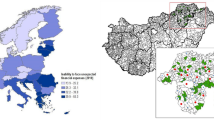Abstract
The aim of this paper is to indicate factors which have a significant impact on having a consumer credit or a mortgage loan among people over the age of 50. The article contains results of a research which was carried out in the period from April to May 2016. Respondents of this research were people over the age of 50 who live in lubelskie region (Poland). The sample reflects the proportion of age groups in tested population (stratified sampling). In order to reach the goal of this paper and verify stated hypotheses, statistical tests of significance and binary logistic regression were used. The conducted study revealed that supporting family is a strong motive, which has an impact on having or not consumer or mortgage loan. Moreover, the willingness to help family financially is much more important than any other financial reason or obstacle. At the same time, the level of trust in family is not important when people borrow money for them.
Access this chapter
Tax calculation will be finalised at checkout
Purchases are for personal use only
Similar content being viewed by others
References
Albertini M, Kohli M (2013) The generational contract in the family: an analysis of transfer regimes in Europe. Eur Soc Rev 29(4):828–840
Albertini M, Radl J (2012) Intergenerational transfers and social class: inter-vivos transfers as means of status reproduction? Acta Sociologica 55(2):107–123. doi:10.1177/0001699311431596
Biuro Informacji Kredytowej (2015) www.bik.pl/informacje-prasowe/-/article/2015-05-25-portret-polskiego-kredytobiorcy. Accessed 1 Sept 2016
Buk M, Pustiowska N (2013) Wykluczenie osób starszych na rynku finansowym—wyniki badań jakościowych. In: Kubicki P (ed) Osoby starsze na rynku usług finansowych analiza i zalecenia, Warszawa, pp 41–52
Bursac Z, Gauss C, Williams D et al (2008) Purposeful selection of variables in logistic regression. Source Code Biol Med:3–17. doi:10.1186/1751-0473-3-17
Canchola JA, Otero-Sabogal R, Owens D, et al (2015). Logistic regression model-building strategies for predicting regular mammography screening adherence among uninsured immigrant women. Available via www.researchgate.net/publication/254285103_Logistic_regression_model-building_strategies_for_predicting_regular_mammography_screening_adherence_among_uninsured_immigrant_women
Central Statistical Office of Poland (2016) Household budget survey in 2015, www.stat.gov.pl. Accessed 1 Dec 2016
Cynamon BZ, Fazzari SM (2008) Household debt in the consumer age: source of growth-risk of collapse. Capital Soc 3(2):1–32
Debelle G (2004) Household debt and the macroeconomy. BIS Q Rev 2004:51–64
Finney A (2013) Demystifying non-mortgage borrowing in older age: a longitudinal approach. ILC-UK, London
Georgarakos D, Haliassos M, Pasini G (2014) Household debt and social interactions. Rev Financ Stud 27(5):1404–1433
Jamieson S (2004) Likert scales: how to (ab)use them. Med Educ 38(12):1217–1218
Kohli M, Künemund H (2003) Intergenerational transfers in the family: what motivates giving? In: Bengtson VL, Lowenstein A (eds) Global aging and challenges to families. Aldine de Gruyter, New York, pp 123–142
Kuchciak I (2014) Świadomość finansowa osób w wieku 50+ a korzystanie z produktów bankowych. Annales UMCS Sectio H XLVIII(4):83–92
Nicińska A, Kalbarczyk M (2009) Finansowe i niefinansowe transfery w próbie SHARE. Polityka Społeczna 4:13–18
Polish Financial Supervision Authority (2013) Rekomendacja S
Smyczek S, Matysiewicz J (2014) Financial exclusion as barrier to socio-economic development of the Baltic Sea Region. J Econ Manag 15:79
Tranmer M and Elliot M (2008) Binary logistic regression, Cathie Marsh for census and survey research, paper, 20
Ziemba M, Świeszczak K and Marcinkowska M (2014) Wykluczenie finansowe osób 50 + w kontekście dostępnej oferty bankowej. FINANSE Czasopismo Komitetu Nauk o Finansach PAN 1(7):145–170
Author information
Authors and Affiliations
Corresponding author
Editor information
Editors and Affiliations
Rights and permissions
Copyright information
© 2017 Springer International Publishing AG
About this paper
Cite this paper
Lewicka, B. (2017). Supporting Family to Their Utmost—People’s over the Age of 50 Attitudes to Borrowing. In: Jajuga, K., Orlowski, L., Staehr, K. (eds) Contemporary Trends and Challenges in Finance. Springer Proceedings in Business and Economics. Springer, Cham. https://doi.org/10.1007/978-3-319-54885-2_28
Download citation
DOI: https://doi.org/10.1007/978-3-319-54885-2_28
Published:
Publisher Name: Springer, Cham
Print ISBN: 978-3-319-54884-5
Online ISBN: 978-3-319-54885-2
eBook Packages: Economics and FinanceEconomics and Finance (R0)




